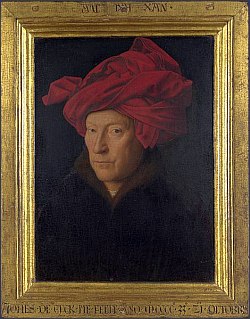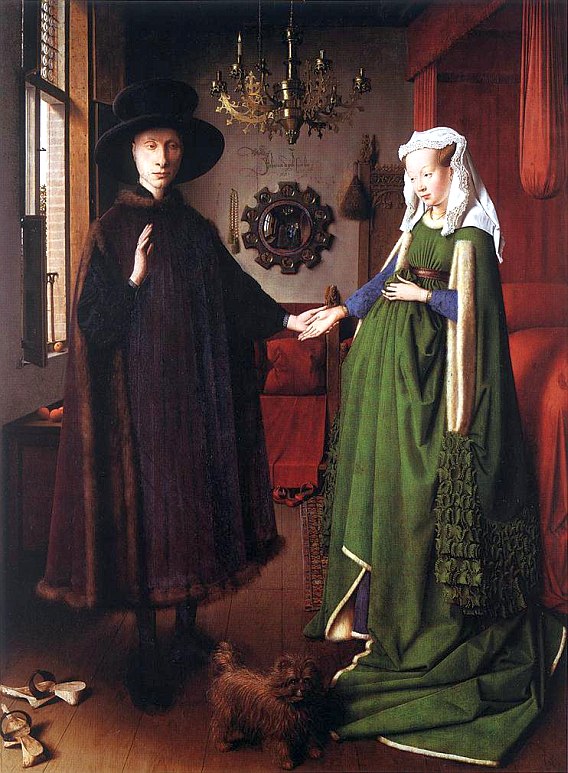Eyck, Jan van
 Only four years his junior, Jan van Eyck is thought to have studied under his brother Hubert (1366-1426). In fact, one of Jan's earliest and most famous works was begun by his brother. Jan is perhaps the more well-known of the two but it might not entirely be due to his painting skills alone.
Only four years his junior, Jan van Eyck is thought to have studied under his brother Hubert (1366-1426). In fact, one of Jan's earliest and most famous works was begun by his brother. Jan is perhaps the more well-known of the two but it might not entirely be due to his painting skills alone.
The Eyck brothers and many of the other 15th century artists specialized in frescoes and portraits. There were no art supply stores where they could pick up a few tubes of paint. They or their assistants would grind a variety of pigments and add a wetting agent – most commonly diluted egg – to make their own paints. The egg-pigment paint was known as tempura. Tempura was a thin and tough medium which suited medieval tastes which called for flat color surfaces. The problems with tempura were that it dried extremely quickly and required a preservative of a finish varnish or chemical preparation to preserve the colors. Blending colors was virtually impossible, the darks were quite muddy in appearance and it was extremely difficult to create three-dimensional effects.
Jan van Eyck was most likely not the first painter to experiment with other mediums. In fact, Theophilus and Cennino wrote of using oil and pigments in the Middle Ages. Prior to Eyck, oil painting was reserved for wooden statues, stone surfaces or metal. But his knowledge of chemistry and a great deal of trial and error, he led a revolution in the process of painting – the introduction of oil painting on panels in 1410. Eyck discovered that colors prepared with linseed or walnut oil retained their beauty and luster, without the aid of varnish. His oil paints took longer to dry which gave the artist more time and the ability to apply transparent layers or “glazes” to achieve glittering highlights and details far beyond what any artist was able to do with tempura.
While many still question if van Eyck should be credited with inventing oil paint, most agree his techniques wer revolutionary. Prior to his use of oils, paints were applied in a similar fashion to a paint by number kit. The tempura dried so very quickly that each color dried before the next could be applied. Colors were strongly delineated and almost separated. With oil-based paints, van Eyck mixed the colors together on both his palette and the picture itself to create paintings which more closely represented the truth of nature.
This innovation, in some opinions, marked the beginning of the end of wall painting as art. Master artists turned to easel painting and wall painting was delegated to 'mere craftsmen'.
The van Eycks have also been credited with the invention of “atmospheric perspective.” Atmospheric perspective is a technique where greater depth and distance are created by painting distant objects with paler colors, fewer details and often a bluish cast.
You have probably seen this phenomenon if you have visited a location with mountains off in the distance. This bluish cast is created when sunlight travels through water vapor. Some areas of the world are more prone to this phenomenon like the Blue Ridge Mountains of the southeastern United States which are named for the bluish haze that seems to hang over the mountain ridges.
Jan van Eyck was thought to have been born sometime between 1380 and 1395, though most historical references we have found seem to favor 1380 or 1390 as his year of birth (for the sake of expediency, The Famous Artists will use 1380).
Eyck's earliest known piece is signed and dated October 30, 1421. It depicts the Consecration of Thomas a Becket as Archbishop of Canterbury.
Between October 1422 and September 1424, Eyck was at the Hague, serving as painter and “varlet de chambre” to John III the Pitiless, Duke of Bavaria-Staubing. After the Duke's death, Eyck was given similar patronage by Phillip the Good, Duke of Burgundy. Eyck's service to Duke Phillip went beyond art. Eyck is known to have been sent on several secret diplomatic missions for the Duke. What a clever cover – he visited important people under the guise of painting their portrait. In retrospect, one wonders the real reason van Eyck was sent in October of 1428 to paint a portrait of Princess Isabella of Portugal, who would become the Duke's 3rd wife in 1430 and produce his only two sons, Charles the Bold and David of Burgundy.
van Eyck returned home around Christmas in 1429, a passenger on the Princess's train. He settled in Ghent to finish his famous Ghent Altarpiece begun earlier by his brother Hubert. After completing the altarpiece in 1432, Jan purchased a house in Bruges.
The Duke paid Eyck a substantial salary, obviously treasuring his contributions to art and science as well as his diplomatic missions. When the Duke was forced to stop all court salaries due to a shortage of funds, only Eyck continued to be paid. The Duke was named godfather to one of Jan van Eyck's children, supported Eyck's widow upon the artist's death and helped one of Eyck's daughters purchase her entrance to a convent.
Historical records and his frequent use of Latin on his paintings would indicate that he was a very scholarly and learned man. He often signed his works on the frames in Latin. Unfortunately, his use of Latin has led to disagreements among art scholars over several of his works, including the painting shown here (“Portrait of a Man” or “Portrait of a Man in a Turban”) and most often identified as a self-portrait.
Jan van Eyck painted for the court but was also permitted to accept private commissions. The Ghent Altarpiece is but one example. His last known paintings were dated 1439 – a portrait of his wife and a small Madonna. Jan van Eyck died in Bruges in 1441.

For centuries, scholars attached a bit of folklore and more than a little symbolism to the elements of this painting. Modern scholars have introduced new theories that even cast doubt on who is depicted in the painting. Regardless of what…
Read more

 Only four years his junior, Jan van Eyck is thought to have studied under his brother Hubert (1366-1426). In fact, one of Jan's earliest and most famous works was begun by his brother. Jan is perhaps the more well-known of the two but it might not entirely be due to his painting skills alone.
Only four years his junior, Jan van Eyck is thought to have studied under his brother Hubert (1366-1426). In fact, one of Jan's earliest and most famous works was begun by his brother. Jan is perhaps the more well-known of the two but it might not entirely be due to his painting skills alone.